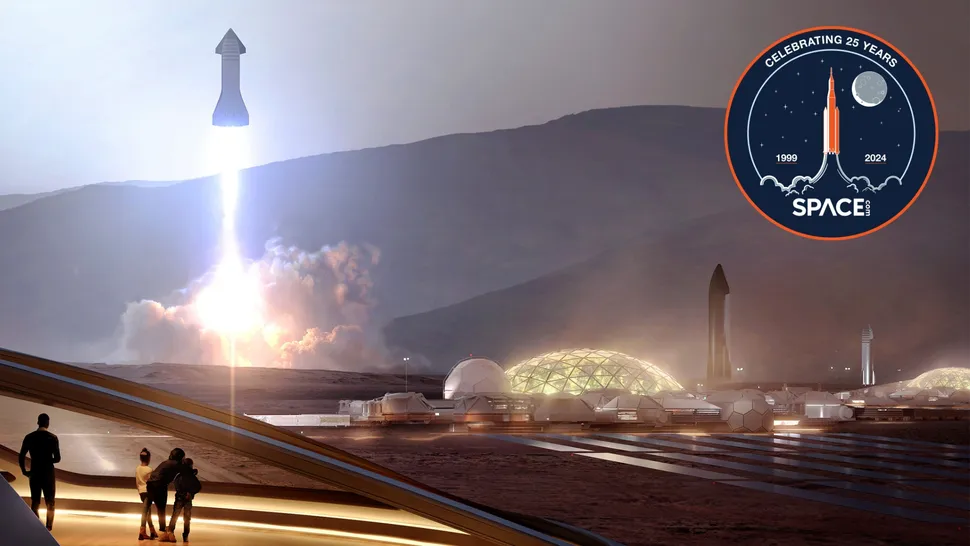Spaceflight and exploration have undergone remarkable transformations over the past 25 years, shaping the current landscape of our journey into the cosmos. Since 1999, we’ve witnessed the rise of a dynamic private spaceflight sector, spearheaded by Elon Musk’s SpaceX, and the emergence of China as a major player in space exploration. Additionally, India has made significant strides in the space arena.
As we look ahead to 2049, the next quarter-century promises even greater advancements in space exploration and technology. While predicting the future is inherently uncertain, several key trends and developments appear poised to define the trajectory of spaceflight in the coming decades.
The Continued Expansion of Private Spaceflight
The private spaceflight sector is set to expand significantly, with SpaceX at the forefront, routinely launching missions to orbit for both NASA and private clients such as Houston-based Axiom Space. Boeing’s Starliner capsule recently completed its inaugural crewed flight, demonstrating the increasing capability of private space vehicles.
Virgin Galactic and Blue Origin, founded by Richard Branson and Jeff Bezos respectively, have also entered the human spaceflight arena. Both companies have successfully launched paying customers on suborbital flights, offering brief but exhilarating trips to space.
In addition to crewed missions, private companies like SpaceX, Firefly Aerospace, Rocket Lab, United Launch Alliance, and Arianespace are actively engaged in satellite launches. The payload sector is booming, driven by lower launch costs and technological advancements that have made satellite manufacturing more affordable and efficient. Companies such as Planet and Capella Space are leading the way with their Earth-observing satellite constellations, providing valuable imagery for various applications.
The Rise of Satellite Megaconstellations
A notable trend is the proliferation of satellite mega-constellations. SpaceX’s Starlink, with over 6,100 operational satellites in low Earth orbit (LEO), is a prime example. Similarly, OneWeb and other companies are building their own large-scale satellite networks to provide global internet coverage.
This surge in commercial activity is expected to intensify, according to Aaron Kemmer, co-founder of Max Space. Kemmer anticipates a multi-decade space boom, characterized by an exponential increase in space startups and investment. The introduction of more rockets, such as Rocket Lab’s Neutron and other forthcoming vehicles from companies like Relativity Space and ABL Space Systems, is likely to drive down launch costs through increased competition.

Advancements in Rocket Technology
The future of spaceflight will also see advancements in rocket technology. Blue Origin’s partially reusable New Glenn rocket and SpaceX’s fully reusable Starship are set to revolutionize space access. Starship, in particular, could dramatically lower launch costs to as little as $2 million to $3 million, potentially making space more accessible to a broader range of customers.
Space policy expert John Logsdon predicts that improvements in rocket reliability and new technologies could significantly impact space exploration. Innovations in off-Earth manufacturing and resource utilization, such as those pursued by Varda Space and Space Solar, may also contribute to the growth of the space economy.
Addressing Space Junk and Sustainability
The growing activity in space raises concerns about space debris. With thousands of satellites and future projects like Starlink potentially contributing to the issue, managing space junk will become increasingly important. Efforts are underway to tackle this problem, including initiatives by companies like Astroscale and LeoLabs, which focus on debris mitigation and tracking.
China’s Ascension and Future Competitions
China’s ascent in space exploration has been notable. Since becoming the third nation to send humans to orbit in 2003, China has made significant progress, including the successful completion of its Tiangong space station and ambitious lunar exploration missions. As China continues to develop its space capabilities, it aims to establish a crewed lunar base in the 2030s, competing with NASA’s Artemis program.
The U.S. faces a competitive challenge, with American officials emphasizing the need to maintain leadership in space. Other nations, including India and potential resurgents like Russia, may also play pivotal roles in shaping the future of space exploration.
The Future of Off-Earth Settlements
As the International Space Station (ISS) nears its retirement in 2030, private space stations are expected to fill the void. Companies like Axiom Space, Blue Origin, and Northrop Grumman are working on new outposts that could be operational by 2049. Meanwhile, the dream of establishing human settlements on the Moon and Mars continues.
The Moon, with its proximity to Earth, is a more viable candidate for early colonization. Both the U.S. and China are planning lunar bases, and experts like Kemmer and Logsdon are optimistic about the prospect of a human presence on the Moon by 2049. Mars, while more challenging due to its distance and environmental conditions, remains a long-term goal, with SpaceX’s ambitious plans potentially paving the way for future missions.
Looking Ahead
As we approach 2049, the landscape of space exploration will be shaped by ongoing advancements, new technologies, and international competition. While the future holds immense potential, it’s important to temper expectations with the understanding that not all visions will come to fruition as anticipated.








